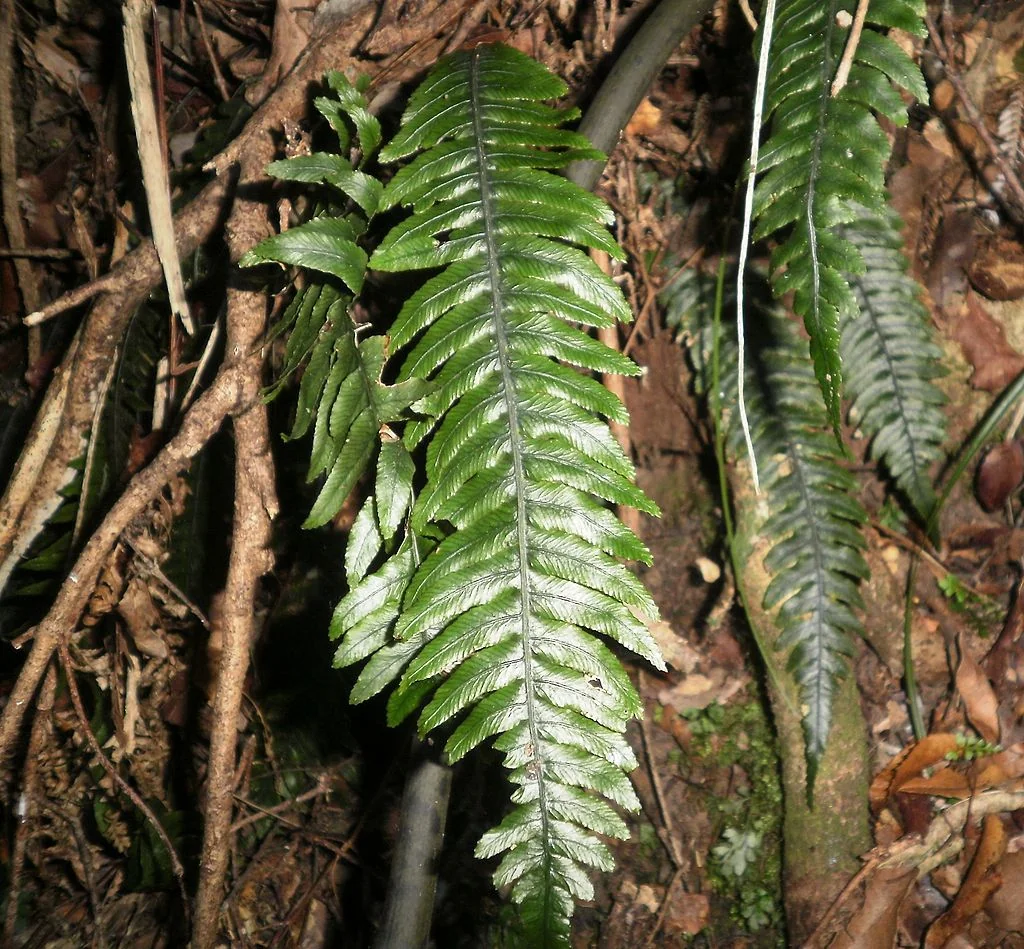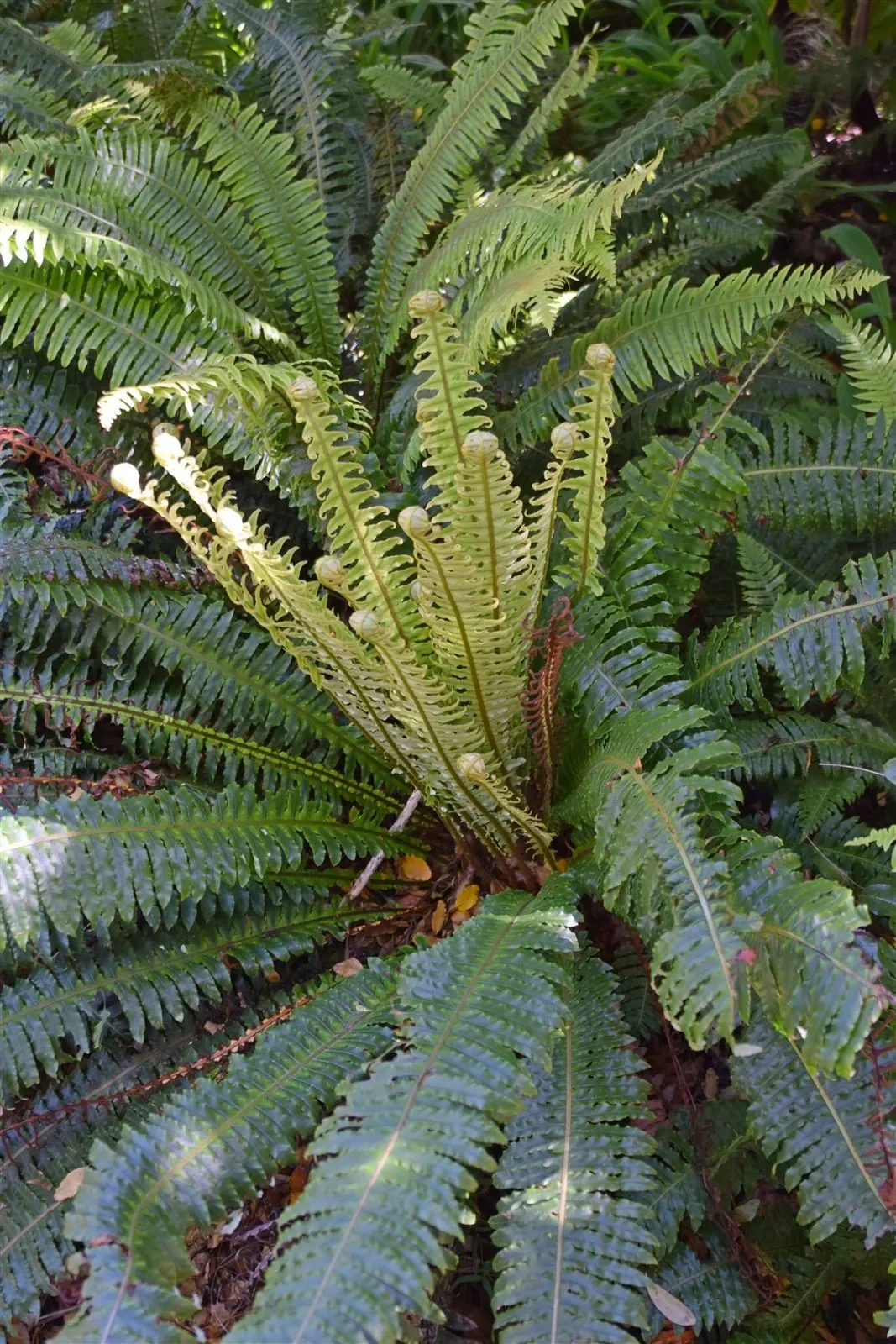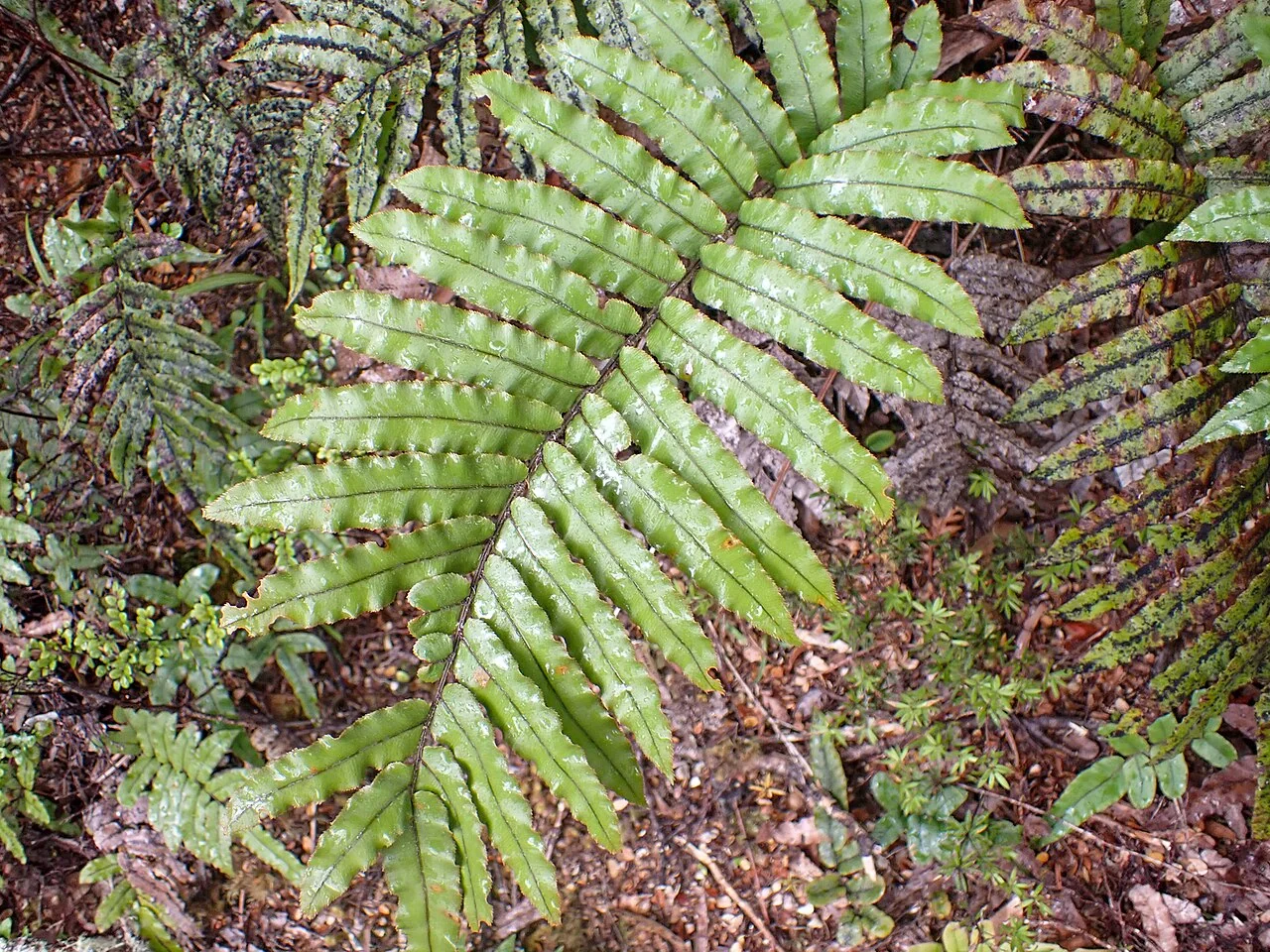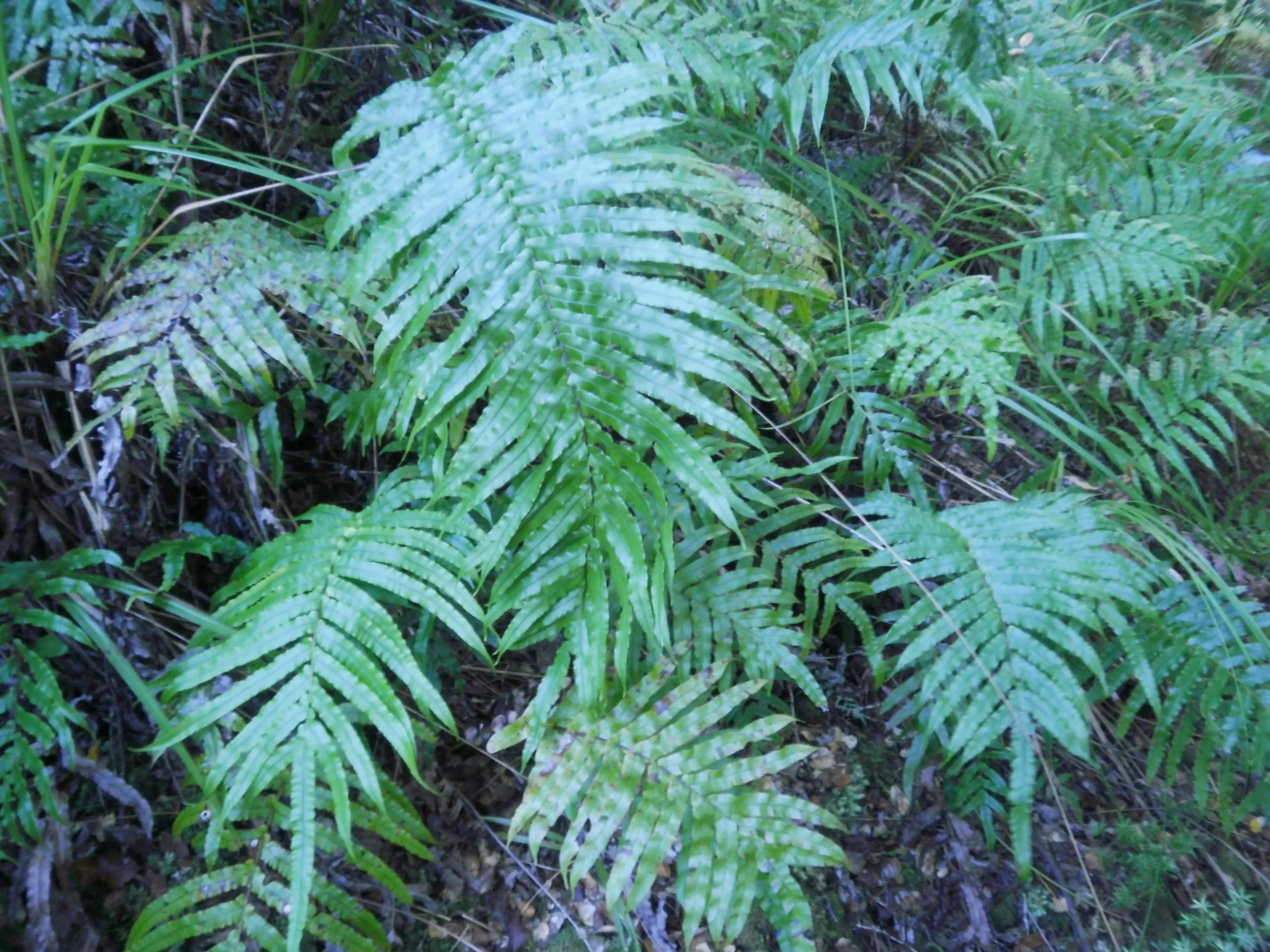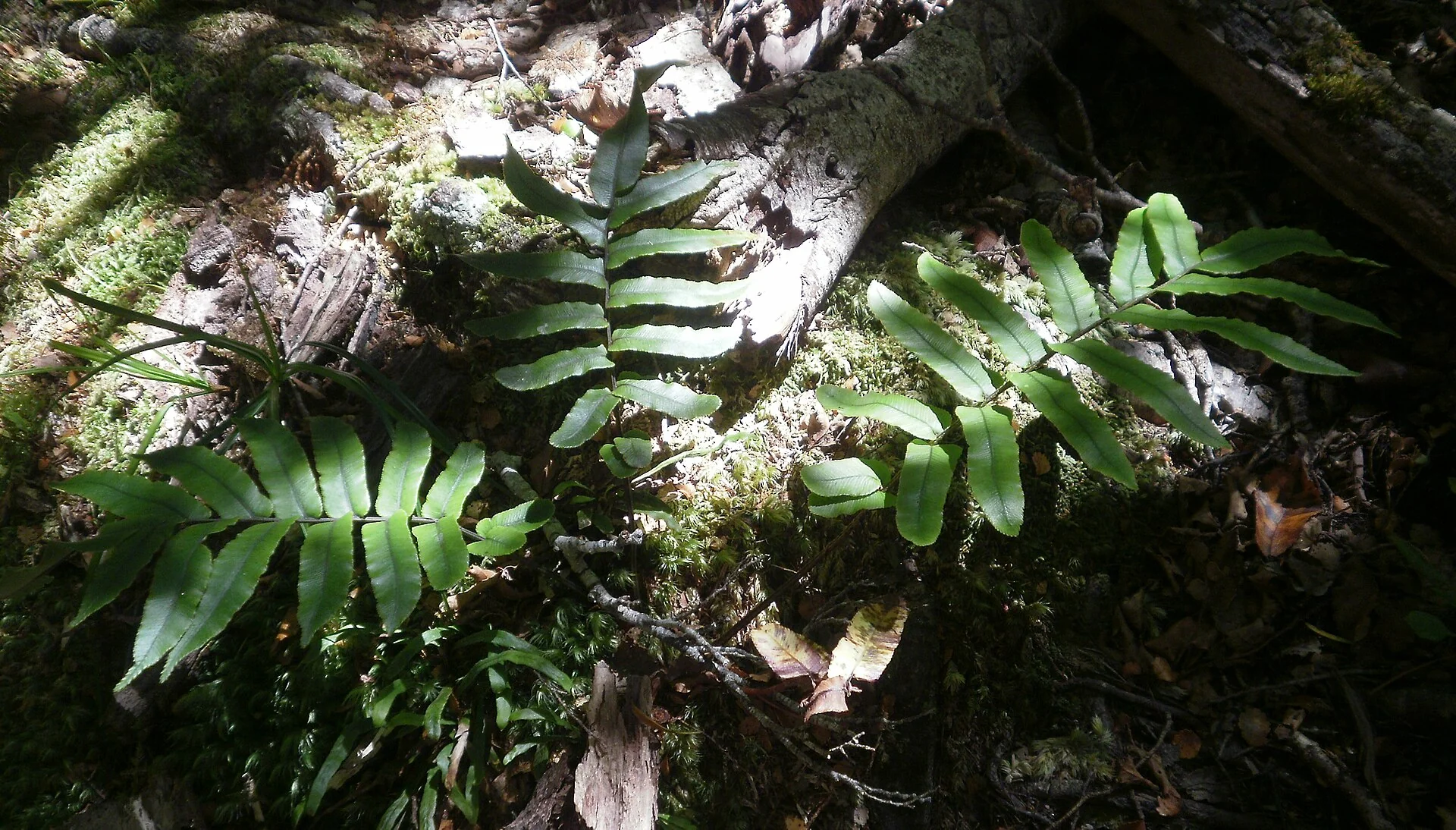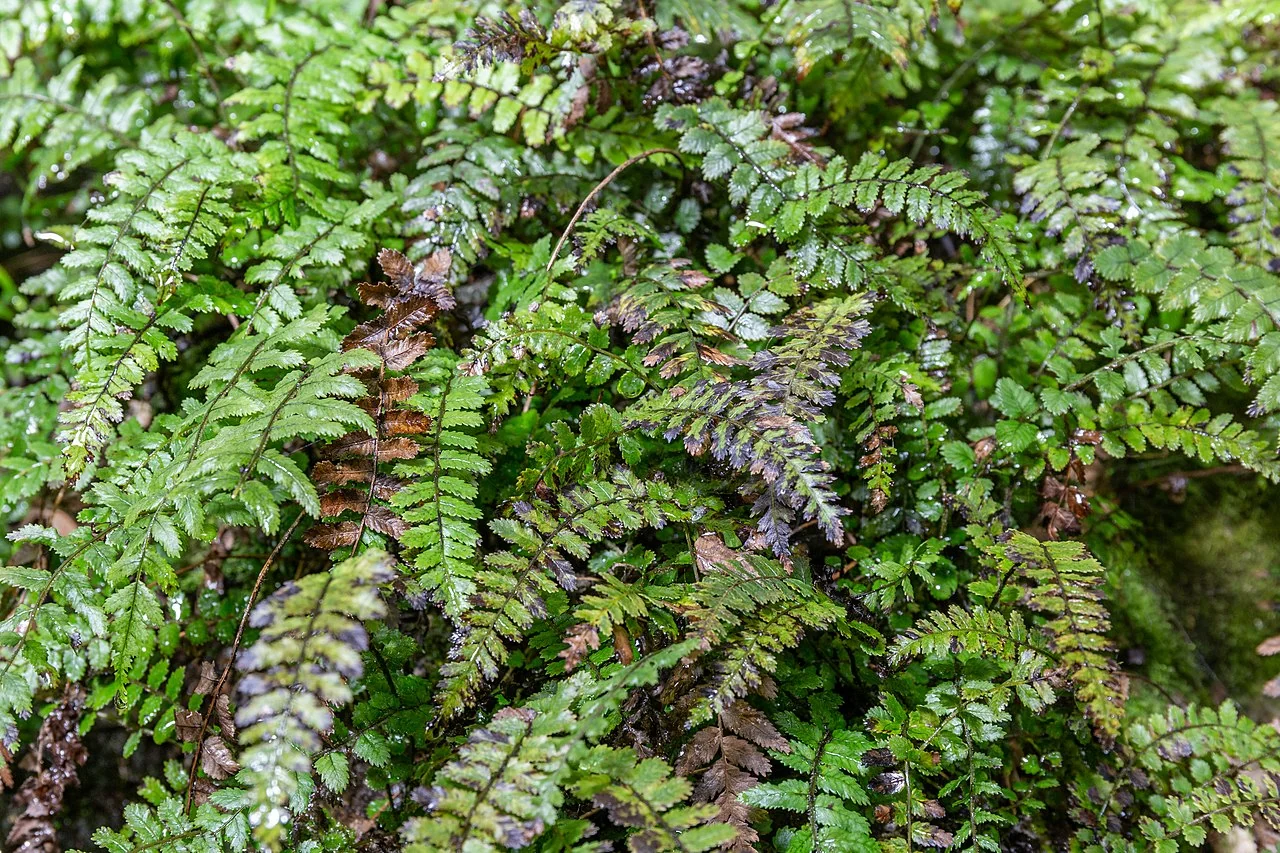
Climbing Hard Fern
Blechnum filiforme
Explore more NZ native plant guides in our index .
Introduction
About Climbing Hard Fern
Blechnum filiforme , commonly known as Climbing Hard Fern or Thread Fern, is a unique native fern of New Zealand. It is characterized by its dimorphic fronds: sterile fronds that are broad and leafy, and fertile fronds that are long, slender, and thread-like, often climbing up tree trunks or other supports. This fern is a prominent feature of damp, shady forest environments.

Plant Description
Blechnum filiforme , or Climbing Hard Fern, is a unique and fascinating native fern of New Zealand, distinguished by its climbing habit and its different types of fronds. The juvenile sterile fronds are small and rounded, forming a creeping mat on the forest floor. As the fern matures, it begins to climb, producing larger, more elongated sterile fronds. Finally, the adult fertile fronds appear, which are long, slender, and thread-like, giving the fern its common name. These fertile fronds can climb several meters up tree trunks, creating a dramatic vertical element in the forest understory.
Quick Facts
Fern Summary
| Scientific Name | Blechnum Filiforme |
|---|---|
| Height | Sterile fronds 10-30 cm; fertile fronds up to 2 m |
| Spread | 30-50 cm |
| Water Needs | Moderate to high; prefers consistently moist soil |
| Light | Partial to full shade |
| Frost Tolerance | Moderate |
| Salt Tolerance | Low |
| Growth Rate | Moderate |
| Lifespan | Perennial |
Climate Best Suited to
Blechnum filiforme is found throughout New Zealand in lowland to montane forests. It thrives in a mild, humid climate with consistent moisture and protection from strong winds and direct sunlight.
Regional Suitability
| Whangārei | Ideal |
| Auckland | Ideal |
| Hamilton | Suitable |
| Rotorua | Suitable |
| Tauranga | Ideal |
| Gisborne | Ideal |
| New Plymouth | Ideal |
| Whanganui | Ideal |
| Palmerston North | Suitable |
| Napier | Ideal |
| Wellington | Ideal |
| Nelson | Ideal |
| Christchurch | Suitable |
| Dunedin | Suitable |
| Invercargill | Suitable |
| City | Climate Suitability |
|---|
Habitat
Natural Distribution
Blechnum filiforme , also known as Thread Fern or Climbing Hard Fern, is a unique fern endemic to New Zealand. It is primarily found in coastal and lowland areas of the North Island (from Te Paki to Wellington) and the South Island (from Cape Farewell to the Marlborough Sounds), as well as on the Three Kings Islands and Chatham Islands.
Its natural habitat includes a variety of forest types, such as podocarp and broadleaved forests, and less commonly, beech forests, coastal scrub, and areas under mānuka or kānuka. It typically grows on river terraces, hillsides, banks, and in gullies. Juvenile plants initially creep along the ground, over rocks, and logs before developing their climbing habit, ascending various forest trees and tree ferns. This fern can be found from near sea level up to an altitude of 780 meters, though it is uncommon above 500 meters.
Plant Conservation
Threats and Efforts
Climbing Hard Fern ( Blechnum filiforme , now Icarus filiformis ) is a native New Zealand fern with a national conservation status of "Not Threatened." This classification reflects its stable populations in suitable forest habitats throughout New Zealand, where it forms an important component of diverse fern communities.
Despite its secure national status, climbing hard fern faces ongoing conservation challenges due to its specialized habitat requirements and unique life cycle. The primary threats include habitat loss and fragmentation through deforestation and land conversion, which reduces the continuous forest areas necessary for this species' complex climbing lifestyle. Its dependence on mature host trees for support makes it vulnerable to forestry practices that remove large trees and alter forest structure. Changes to forest composition, particularly the loss of diverse canopy layers that provide appropriate climbing opportunities, can significantly impact local populations. Competition from invasive plant species, soil disturbance, and edge effects in fragmented forests also pose challenges to the establishment of its ground-creeping juvenile forms. The species' unique growth habit, transitioning from ground-dwelling juveniles to canopy-climbing adults, requires intact forest ecosystems with appropriate understory and canopy conditions. Conservation efforts focus on protecting continuous forest habitats, maintaining diverse forest age structures that provide suitable host trees, controlling invasive species, and supporting forest management practices that preserve the complex vertical structure this species requires. Its role as an indicator of healthy, mature forest ecosystems makes its conservation valuable for monitoring overall forest biodiversity and ecosystem integrity. By supporting native forest protection, sustainable forestry practices, and habitat restoration that includes vertical complexity, we can help ensure the continued survival of this unique and ecologically specialized native fern.
Growing Requirements
Soil Requirements
Prefers moist, well-drained, humus-rich soil.
Light Requirements
Thrives in partial to full shade. Avoid direct sunlight, which can scorch the fronds.
Water Requirements
Requires consistent moisture, especially during dry periods. Do not allow the soil to dry out completely.
Planting Guide
-
When to Plant
Plant in autumn or spring.
-
Site Preparation
Choose a shady site with moist, well-drained, humus-rich soil.
-
Planting and Aftercare
Dig a hole twice the width of the root ball. Place the fern in the hole, ensuring the crown is level with the soil surface. Backfill with soil and water thoroughly. Apply a layer of mulch.
Ecological Significance
Blechnum filiforme , also known as Thread Fern or Pānako, is a high-climbing fern endemic to New Zealand, holding unique ecological significance as the only climbing species within the Blechnum genus in the region. Its ecological role is shaped by its distinctive growth habit and habitat preferences.
- Habitat Indicator: The presence of Blechnum filiforme is a good indicator of specific forest types, thriving in podocarp and broadleaved forests, and less commonly in beech forests, coastal scrub, and under mānuka or kānuka. It is typically found on river terraces, hillsides, banks, and in gullies, signifying areas with consistent moisture and suitable light conditions.
- Structural Influence: This fern exhibits a unique life cycle, starting as juvenile plants creeping along the ground, over rocks and logs. As it matures, it develops into a high-climbing adult, ascending various forest trees and tree ferns. This climbing behavior can significantly influence forest structure, as the fern can eventually completely cover the trunk of its host tree, potentially impacting the host's health and the overall forest dynamics.
- Biodiversity Contribution: As an endemic species, Blechnum filiforme contributes to the unique biodiversity of New Zealand's fern flora. Its distinct trimorphic fronds (juvenile, adult sterile, and adult fertile) are an unusual feature among ferns, with sterile fronds performing photosynthesis and fertile fronds responsible for reproduction via spores. This specialized morphology adds to the ecological complexity of its environment.
Uses and Significance
Garden Uses
- An excellent fern for shady borders, woodland gardens, and as a climbing plant on tree trunks or other supports.
- Its unique dimorphic fronds make it a conversation piece.
Cultural Significance
Traditional Uses and Values
While not as widely documented for traditional Māori uses as some other ferns, the unique climbing habit of Climbing Hard Fern ( Blechnum filiforme ) was observed and appreciated. Its presence in the landscape was a sign of a healthy, moist forest environment.
Landscaping Uses
Garden Design Applications
Blechnum filiforme , also known as Thread Fern or Climbing Hard Fern, is a versatile native fern with several valuable landscaping applications, particularly in shaded, moist environments. This evergreen fern offers a lush, green backdrop and can be utilized in various ways to enhance garden spaces.
- Woodland and Shaded Rock Gardens: It is an ideal choice for woodland and shaded rock gardens, where its lovely foliage and shade-loving nature allow it to thrive. It can effectively soften the edges of stones in rock gardens, providing a serene contrast.
- Groundcover and Underplanting: The fern works exceptionally well as a dense and attractive groundcover in shaded areas. It is also ideal for planting beneath taller trees or shrubs, adding a lush layer that complements other garden features and helps retain soil moisture.
- Shaded Borders: Blechnum filiforme is perfect for creating shaded borders that blend seamlessly with the natural landscape, providing a continuous green element.
- Pots and Planters: For those with limited garden space or who wish to highlight its unique climbing habit, it can be grown in pots or planters, bringing greenery to patios or balconies.
- Climbing Feature: Its ability to climb makes it a distinctive feature when allowed to ascend tree trunks or other supports, adding a vertical dimension to the garden.
Beyond its aesthetic appeal, Blechnum filiforme also contributes to biodiversity by offering shelter for small wildlife and supporting a balanced ecosystem. It prefers moist, acidic soil and requires minimal maintenance once established, making it a rewarding addition to a native plant garden.
Seasonal Care Calendar
Spring
- Apply a layer of compost or leaf mould to enrich the soil and retain moisture.
Summer
- Water regularly, especially during dry periods.
Autumn
- No special care required.
Winter
- Protect from heavy frosts in colder regions.
Pruning and Maintenance
Frond Care
Remove any old, damaged, or yellowing fronds as needed to maintain the plant's appearance.
Prune Climbing Hard Fern lightly to maintain structure; remove damaged shoots and avoid hard cuts on older wood.
How to Grow Climbing Hard Fern
From Spores
Propagating Climbing Hard Fern from spores offers insight into the fascinating life cycle of New Zealand's only climbing Blechnum species. This method requires patience and understanding of the fern's unique developmental stages, from juvenile ground-creeping forms to adult climbing stages. Spore propagation is particularly valuable for this species as it maintains genetic diversity and allows observation of the remarkable morphological changes from juvenile to adult fronds. The process is challenging but rewarding for dedicated fern enthusiasts. Wind-dispersed spores can be collected when fertile fronds mature, typically high up in the canopy where adult fertile fronds develop.
- Collect fertile fronds from climbing adult plants when sori turn brown, usually in late summer
- Access to fertile fronds may require climbing or waiting for naturally fallen fronds
- Place collected fronds in paper bags and allow spores to release over 2-3 days in a dry location
- Prepare sterile growing medium of equal parts peat moss and fine perlite, sterilized with boiling water
- Sow spores thinly on surface of cooled, moist medium in covered containers
- Maintain high humidity (85-90%) and temperature of 18-22°C in bright, indirect light
- Tiny green prothalli will appear in 6-10 weeks, requiring continued moisture
- Young ferns emerge after 4-8 months and initially show juvenile creeping characteristics
- Transplant carefully when plants reach 3-5 cm and provide climbing support early
Spore-grown plants may take 2-3 years to reach climbing stage and several more years to produce fertile fronds.
From Division
Division is the most practical propagation method for Climbing Hard Fern, taking advantage of its natural vegetative reproduction capability. This method works well with the rhizomatous base of established plants and maintains the exact characteristics of the parent. Division is particularly effective because this species can regenerate vegetatively from rhizome sections. The technique requires careful handling due to the fern's complex root system and climbing nature. Success rates are high when proper timing and environmental conditions are maintained during the establishment phase.
- Select healthy, established plants in early spring before active growth resumes
- Carefully trace the climbing stems back to the base rhizome system
- Excavate around the base to expose the main rhizome and any offshoots
- Use a sharp, sterile knife to separate rhizome sections ensuring each has growing points
- Allow cut surfaces to dry for several hours to prevent fungal infection
- Plant divisions in humus-rich, well-draining soil with adequate organic matter
- Provide immediate support structures for the climbing growth habit
- Maintain consistent moisture and high humidity during 8-12 week establishment period
- Protect from direct sunlight and strong winds until new growth appears
Divided plants typically establish within 2-3 months and begin climbing within the first growing season.
From Rhizome Cuttings
Rhizome cutting propagation takes advantage of the fern's natural ability to regenerate from root segments, particularly effective for this vigorous climbing species. This method allows creation of multiple plants without disturbing the main specimen and works well with the extensive rhizome system that develops in mature plants. Rhizome sections retain the genetic programming for the distinctive juvenile-to-adult transition that characterizes this unique fern. The technique requires understanding of the plant's growth patterns and careful timing for optimal success rates.
- Locate healthy rhizome sections during the dormant season in late winter
- Excavate carefully to find rhizome pieces with visible buds or growth nodes
- Cut rhizomes into 8-12 cm sections, ensuring each piece has at least one bud
- Dust cut ends with fungicide powder to prevent rot during establishment
- Plant sections horizontally in shallow pots with moisture-retentive growing medium
- Cover lightly with 2-3 cm of soil mix, leaving any emerging shoots exposed
- Maintain warm, humid conditions (20-24°C) in filtered light
- New shoots should emerge within 6-8 weeks if conditions are optimal
- Allow full establishment for 4-6 months before transplanting to permanent locations
Pests and Diseases
Common Problems
Climbing Hard Fern is generally robust and pest- and disease-free when grown in conditions that mimic its natural damp, shady forest habitat. However, it can be susceptible to root rot if left in poorly drained or waterlogged soils, particularly around its creeping rhizomes. Ensure good air circulation, especially when grown as a climbing specimen, to mitigate fungal issues. Occasionally, common fern pests like mealybugs or scale insects might appear on fronds, particularly in stressed plants or in overly dry indoor conditions. These can typically be managed with horticultural soap or by improving growing conditions and humidity.
Bonus Tip
Expert Growing Advice
A fascinating aspect of Blechnum filiforme is its unique growth habit, which involves distinct juvenile and adult forms. Juvenile plants initially creep along the ground with short, linear fronds, forming a mat-like cover. As the fern matures, it undergoes a remarkable transformation, becoming a high-climbing fern that develops larger, elongated fronds as it ascends host trees or other supports. This means that when cultivating this fern, you'll observe a significant and visually interesting change in its appearance as it transitions from its terrestrial juvenile stage to its arboreal adult form.
